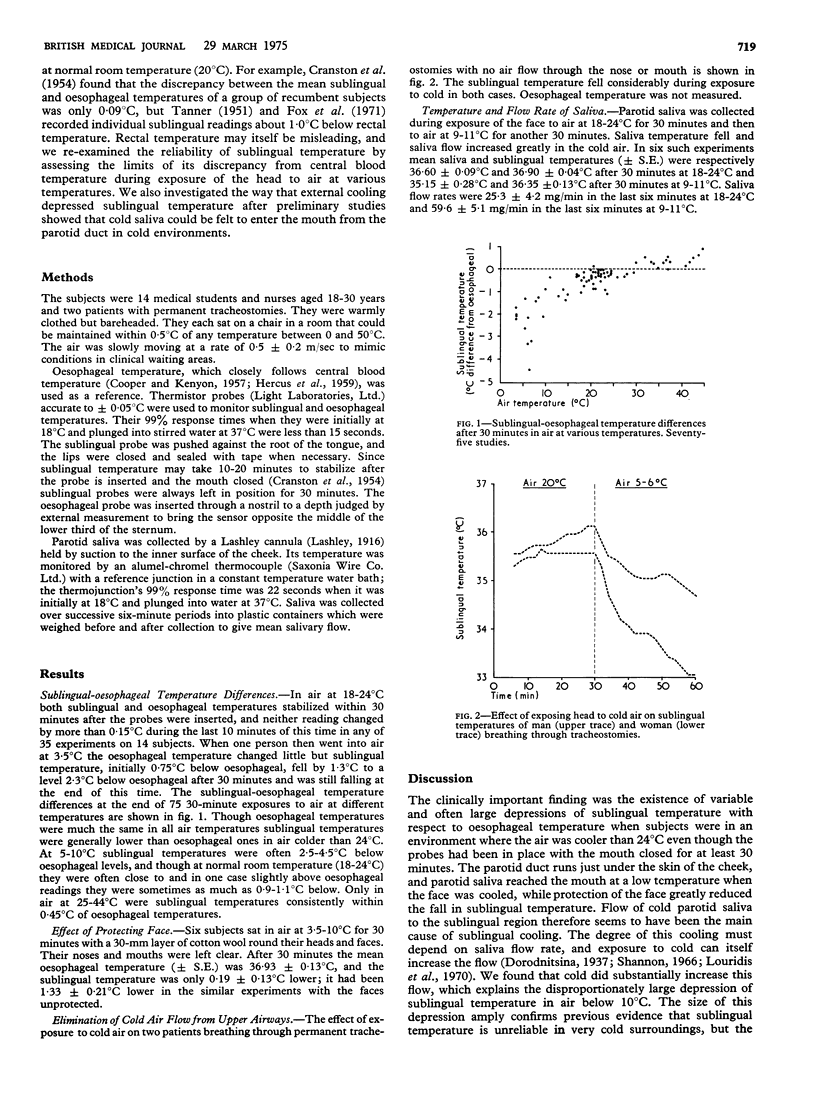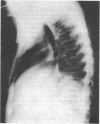Abstract
Sublingual and oesophageal temperatures were compared at various air temperatures in 16 subjects. In warm air (25-44 degrees C) sublingual temperatures stabilized within plus or minus 0-45 degrees C of oesophageal temperatures, but in air at room temperature (18-24 degrees C) they were sometimes as much as 1-1 degrees C below and in cold air (5-10 degrees C) as much as 4-4 degrees C below oesophageal readings. The sublingual-oesophageal temperature difference in cold air was greatly reduced by keeping the face warm, but it was not reduced in two patients breathing through tracheostomies and thereby eliminating cold air flow from the nose and pharynx. Parotid saliva temperature was low and saliva flow high during exposure, and cold saliva seemed to be mainly responsible for the erratic depression of sublingual temperature in the cold. These results indicate hazards in the casual use of sublingual temperatures, and indicate that external heat may have to be supplied to enable them to give reliable clinical assessments of body temperature.
Full text
PDF


Images in this article
Selected References
These references are in PubMed. This may not be the complete list of references from this article.
- COOPER K. E., KENYON J. R. A comparison of temperatures measured in the rectum, oesophagus, and on the surface of the aorta during hypothermia in man. Br J Surg. 1957 May;44(188):616–619. doi: 10.1002/bjs.18004418815. [DOI] [PubMed] [Google Scholar]
- CRANSTON W. I., GERBRANDY J., SNELL E. S. Oral, rectal and oesophageal temperatures and some factors affecting them in man. J Physiol. 1954 Nov 29;126(2):347–358. doi: 10.1113/jphysiol.1954.sp005214. [DOI] [PMC free article] [PubMed] [Google Scholar]
- Cross K. W., Stratton D. Aural temperature of the newborn infant. Lancet. 1974 Nov 16;2(7890):1179–1180. doi: 10.1016/s0140-6736(74)90816-2. [DOI] [PubMed] [Google Scholar]
- Fox R. H., Woodward P. M., Fry A. J., Collins J. C., MacDonald I. C. Diagnosis of accidental hypothermia of the elderly. Lancet. 1971 Feb 27;1(7696):424–427. doi: 10.1016/s0140-6736(71)92414-7. [DOI] [PubMed] [Google Scholar]
- HERCUS V., COHEN D., BOWRING A. C. Temperature gradients during hypothermia. Br Med J. 1959 Jun 6;1(5135):1439–1441. doi: 10.1136/bmj.1.5135.1439. [DOI] [PMC free article] [PubMed] [Google Scholar]
- Keatinge W. R., Sloan R. E. Proceedings: Measurement of deep body temperature from external auditory canal with servo-controlled heating around ear. J Physiol. 1973 Oct;234(2):8P–9P. [PubMed] [Google Scholar]
- Louridis O., Demetriou N., Bazopoulou-Kyrkanides E. Environmental temperature effect on the secretion rate of "resting" and stimulated human mixed saliva. J Dent Res. 1970 Sep-Oct;49(5):1136–1140. doi: 10.1177/00220345700490052301. [DOI] [PubMed] [Google Scholar]
- Shannon I. L. Climatological effects on human parotid gland function. Arch Oral Biol. 1966 Apr;11(4):451–453. doi: 10.1016/0003-9969(66)90109-9. [DOI] [PubMed] [Google Scholar]
- TANNER J. M. The relationships between the frequency of the heart, oral temperature and rectal temperature in man at rest. J Physiol. 1951 Dec 28;115(4):391–409. doi: 10.1113/jphysiol.1951.sp004677. [DOI] [PMC free article] [PubMed] [Google Scholar]



